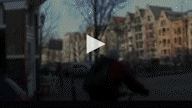The Jodenbreestraat is a street in the centre of Amsterdam, The Netherlands.
In the 17th century, many Jewish emigrants from Portugal and Spain settled in the neighborhood. They founded several synagogues.
The street served as a marketplace until the late 19th century. In 1893, the city government ordered the merchants to move their stalls to nearby Waterlooplein square.
During the German occupation of the Netherlands in World War II, many residents of the Jewish neighourhood were taken away to the concentration camps and killed. After the war, the neighbourhood was left deserted and many of the houses began to fall apart and were eventually torn down.

















































